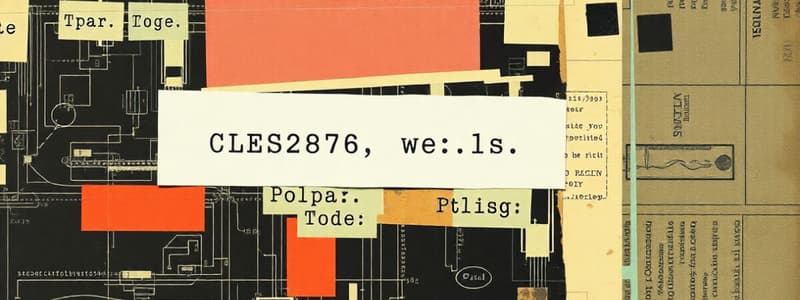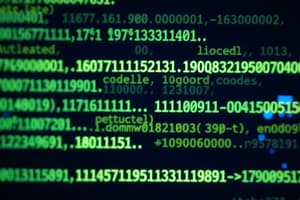Podcast
Questions and Answers
What does the network portion of an IP address indicate?
What does the network portion of an IP address indicate?
- Which network the IP address belongs to (correct)
- The specific device on the network
- The destination MAC address
- The original source of the packet
Which element is NOT part of the three elements common to all communication methods?
Which element is NOT part of the three elements common to all communication methods?
- Source or sender
- Destination or receiver
- Channel or media
- Duration (correct)
The destination MAC address identifies the sending device in a data link frame.
The destination MAC address identifies the sending device in a data link frame.
False (B)
What happens to the data link frame when it reaches a router and needs to be forwarded?
What happens to the data link frame when it reaches a router and needs to be forwarded?
Protocols are not necessary for effective communication.
Protocols are not necessary for effective communication.
The __________ address represents the device that is sending the frame.
The __________ address represents the device that is sending the frame.
What is the process of converting information into another acceptable form for transmission called?
What is the process of converting information into another acceptable form for transmission called?
Putting the letter into the addressed envelope is called ___________.
Putting the letter into the addressed envelope is called ___________.
Match the following IP address components with their descriptions:
Match the following IP address components with their descriptions:
When sending data to a remote network, what must happen with the data link frame?
When sending data to a remote network, what must happen with the data link frame?
Match the types of messaging with their descriptions:
Match the types of messaging with their descriptions:
Which of the following includes the requirements for message delivery?
Which of the following includes the requirements for message delivery?
All message pieces travel together in a single frame across a network.
All message pieces travel together in a single frame across a network.
What must hosts on a network know in relation to sending messages?
What must hosts on a network know in relation to sending messages?
Each frame provides __________ and __________ addresses for proper message delivery.
Each frame provides __________ and __________ addresses for proper message delivery.
Which of the following protocols is responsible for managing conversations between web servers and web clients?
Which of the following protocols is responsible for managing conversations between web servers and web clients?
The Ethernet protocol operates at the application layer of the TCP/IP model.
The Ethernet protocol operates at the application layer of the TCP/IP model.
What does the acronym ICANN stand for?
What does the acronym ICANN stand for?
The process of adding protocol information at each layer is known as __________.
The process of adding protocol information at each layer is known as __________.
Match the following protocol data units (PDUs) with their respective layers:
Match the following protocol data units (PDUs) with their respective layers:
What is the purpose of the source IP address in an IP packet?
What is the purpose of the source IP address in an IP packet?
The OSI model includes the physical layer, which is responsible for the transmission of bits.
The OSI model includes the physical layer, which is responsible for the transmission of bits.
What are the two primary tasks of the Internet Engineering Task Force (IETF)?
What are the two primary tasks of the Internet Engineering Task Force (IETF)?
The __________ layer provides services to segment, transfer, and reassemble the data.
The __________ layer provides services to segment, transfer, and reassemble the data.
Which of these is NOT a benefit of using a layered model in networking?
Which of these is NOT a benefit of using a layered model in networking?
What does the network portion of an IP address identify?
What does the network portion of an IP address identify?
The source MAC address identifies the device that is receiving the frame.
The source MAC address identifies the device that is receiving the frame.
What happens to the data link frame when sending to a remote network?
What happens to the data link frame when sending to a remote network?
The ________ portion of an IP address identifies a specific device on the network.
The ________ portion of an IP address identifies a specific device on the network.
Match the following IP address components with their descriptions:
Match the following IP address components with their descriptions:
What must occur when a data link frame reaches a router?
What must occur when a data link frame reaches a router?
Which of the following is NOT one of the common elements of communication methods?
Which of the following is NOT one of the common elements of communication methods?
Message encoding refers to the process of converting information into bits for transmission.
Message encoding refers to the process of converting information into bits for transmission.
What is the process called when each piece of a long message is sent in separate frames?
What is the process called when each piece of a long message is sent in separate frames?
Each computer message is encapsulated in a specific format called a __________.
Each computer message is encapsulated in a specific format called a __________.
Match the following message delivery options with their definitions:
Match the following message delivery options with their definitions:
Which of the following is a required protocol rule for effective communication?
Which of the following is a required protocol rule for effective communication?
The destination host needs to interpret the received signals to decode the message.
The destination host needs to interpret the received signals to decode the message.
What is it called when hosts negotiate the timing to send messages to avoid overwhelming the destination?
What is it called when hosts negotiate the timing to send messages to avoid overwhelming the destination?
Protocols must specify how long to wait for responses during __________ timeouts.
Protocols must specify how long to wait for responses during __________ timeouts.
Which protocol is responsible for managing conversations between devices?
Which protocol is responsible for managing conversations between devices?
The Internet Engineering Task Force (IETF) is responsible for the development and maintenance of Internet standards.
The Internet Engineering Task Force (IETF) is responsible for the development and maintenance of Internet standards.
What is the purpose of the IP address in an IP packet?
What is the purpose of the IP address in an IP packet?
The __________ layer contains protocols used for process-to-process communications.
The __________ layer contains protocols used for process-to-process communications.
Match the following protocols with their main functions:
Match the following protocols with their main functions:
Which of the following is a benefit of using a layered model in networking?
Which of the following is a benefit of using a layered model in networking?
Data link addresses are used to deliver frames between devices on different networks.
Data link addresses are used to deliver frames between devices on different networks.
What term describes the process of adding protocol information at each layer during data transmission?
What term describes the process of adding protocol information at each layer during data transmission?
The __________ model of networking advocates for the development of Internet standards.
The __________ model of networking advocates for the development of Internet standards.
Match the organizations with their primary focus:
Match the organizations with their primary focus:
Which of the following elements are essential for effective communication protocols?
Which of the following elements are essential for effective communication protocols?
Message encapsulation refers to breaking long messages into smaller pieces before sending.
Message encapsulation refers to breaking long messages into smaller pieces before sending.
What term describes the process of converting information into bits for transmission?
What term describes the process of converting information into bits for transmission?
A frame in network communication serves as an __________, providing destination and source addressing.
A frame in network communication serves as an __________, providing destination and source addressing.
Match the types of message delivery options with their definitions:
Match the types of message delivery options with their definitions:
Which component is NOT typically included in the message timing protocols?
Which component is NOT typically included in the message timing protocols?
What role does the router play in forwarding an IP packet?
What role does the router play in forwarding an IP packet?
The source MAC address identifies the specific device receiving the data link frame.
The source MAC address identifies the specific device receiving the data link frame.
Protocols are not necessary for the effective delivery of messages over a network.
Protocols are not necessary for the effective delivery of messages over a network.
What must happen to a data link frame when sending data to a remote network?
What must happen to a data link frame when sending data to a remote network?
What happens to frames when they are received by the destination host?
What happens to frames when they are received by the destination host?
The __________ method refers to techniques used to avoid collisions when sending messages on a network.
The __________ method refers to techniques used to avoid collisions when sending messages on a network.
The __________ portion of an IP address shows which network the address belongs to.
The __________ portion of an IP address shows which network the address belongs to.
Match the following IP address components with their definitions:
Match the following IP address components with their definitions:
Which of the following describes the role of the Transport layer in the networking model?
Which of the following describes the role of the Transport layer in the networking model?
Encapsulation works from the top layer downwards, while de-encapsulation works from the bottom layer upwards.
Encapsulation works from the top layer downwards, while de-encapsulation works from the bottom layer upwards.
What is the purpose of the Ethernet protocol?
What is the purpose of the Ethernet protocol?
The __________ is responsible for assigning IP addresses and managing domain names.
The __________ is responsible for assigning IP addresses and managing domain names.
Match the following networking protocols with their functions:
Match the following networking protocols with their functions:
What is the main benefit of using a layered networking model?
What is the main benefit of using a layered networking model?
The Physical layer is responsible for data reassembly after transmission.
The Physical layer is responsible for data reassembly after transmission.
The ______ layer provides services to organize dialogue and manage data exchange.
The ______ layer provides services to organize dialogue and manage data exchange.
What role does the Internet Engineering Task Force (IETF) play?
What role does the Internet Engineering Task Force (IETF) play?
Match the following internet organizations with their primary focus:
Match the following internet organizations with their primary focus:
Flashcards are hidden until you start studying
Study Notes
Communication Elements
- All communication methods involve three common elements: source (sender), destination (receiver), and channel (media).
- Effective communication is governed by protocols, which include identified sender and receiver, common language and grammar, speed/timing of delivery, and acknowledgment requirements.
Protocols in Network Communications
- Protocols define message encoding, delivery options (Unicast, Multicast, Broadcast), formatting (identifying sender and receiver), timing (Access Method, Flow Control), and size restrictions leading to message segmentation.
- Communication messages are initially converted into bits, which are encoded into signals (sounds, light waves, or electrical impulses) suitable for the network medium.
Message Transmission and Encapsulation
- Messages are encapsulated in frames which contain addressing information for source and destination, akin to placing a letter in an addressed envelope.
- Each frame is treated as an individual message unit, with a receiving host responsible for reconstructing the original message from these frames.
Flow Control and Access Method
- Hosts employ flow control to avoid overwhelming the recipient and negotiate timing.
- Collisions must be managed, requiring rules for when to send messages and how to react when they occur.
Networking Protocols
- Protocol suites are implemented in software and hardware, featuring layered views where each layer depends on the functionality of the lower layers.
- Common protocols include:
- HTTP (web communication)
- TCP (manages data segments)
- IP (encapsulates segments into packets)
- Ethernet (facilitates data transmission over a network).
Encapsulation Procedure
- Data sent from a web server to a client follows this procedure:
- HTML page sent through the HTTP protocol to the transport layer.
- The transport layer segments the data, adding IP source and destination addresses.
- Ethernet information is added creating the final data link frame.
Internet Governance Organizations
- Internet Society (ISOC): Advocates for open Internet development worldwide.
- Internet Architecture Board (IAB): Manages and develops Internet standards.
- Internet Engineering Task Force (IETF): Develops and maintains Internet and TCP/IP technologies.
- ICANN: Coordinates IP address allocation and domain name management.
- IANA: Manages IP address allocation and protocol identifiers.
- IEEE: Focuses on technological innovation and networking standards.
- ITU-T: Establishes standards for broadband communications and video compression.
Benefits of Layered Model
- Streamlines protocol design, allowing each layer to have defined functions.
- Encourages competition as products from various vendors can interoperate.
- Prevents changes in one layer from disrupting others.
TCP/IP Protocol Model
- Established in the early 1970s as an open standard for internetwork communication.
- Data streams are divided into smaller segments for transmission, known as multiplexing, facilitating simultaneous conversations.
- Encapsulation occurs from application layer down to physical layer, with each layer creating a Protocol Data Unit (PDU):
- Data (application layer)
- Segment (transport layer)
- Packet (network layer)
- Frame (data link layer)
- Bits (physical layer).
Encapsulation and De-encapsulation Process
- Encapsulation goes from data segmentation to adding headers at each layer down to the physical layer.
- De-encapsulation occurs in reverse order upon reception, removing headers sequentially to retrieve the original data.
Addressing in Networking
- Source and destination IP addresses identify the original sender and final receiver.
- Data link addressing, using MAC addresses, facilitates direct delivery within a local network.
- Communication to remote networks involves routing through gateways, where new data link information is appended for forwarding.
Communication Elements
- All communication methods involve three common elements: source (sender), destination (receiver), and channel (media).
- Effective communication is governed by protocols, which include identified sender and receiver, common language and grammar, speed/timing of delivery, and acknowledgment requirements.
Protocols in Network Communications
- Protocols define message encoding, delivery options (Unicast, Multicast, Broadcast), formatting (identifying sender and receiver), timing (Access Method, Flow Control), and size restrictions leading to message segmentation.
- Communication messages are initially converted into bits, which are encoded into signals (sounds, light waves, or electrical impulses) suitable for the network medium.
Message Transmission and Encapsulation
- Messages are encapsulated in frames which contain addressing information for source and destination, akin to placing a letter in an addressed envelope.
- Each frame is treated as an individual message unit, with a receiving host responsible for reconstructing the original message from these frames.
Flow Control and Access Method
- Hosts employ flow control to avoid overwhelming the recipient and negotiate timing.
- Collisions must be managed, requiring rules for when to send messages and how to react when they occur.
Networking Protocols
- Protocol suites are implemented in software and hardware, featuring layered views where each layer depends on the functionality of the lower layers.
- Common protocols include:
- HTTP (web communication)
- TCP (manages data segments)
- IP (encapsulates segments into packets)
- Ethernet (facilitates data transmission over a network).
Encapsulation Procedure
- Data sent from a web server to a client follows this procedure:
- HTML page sent through the HTTP protocol to the transport layer.
- The transport layer segments the data, adding IP source and destination addresses.
- Ethernet information is added creating the final data link frame.
Internet Governance Organizations
- Internet Society (ISOC): Advocates for open Internet development worldwide.
- Internet Architecture Board (IAB): Manages and develops Internet standards.
- Internet Engineering Task Force (IETF): Develops and maintains Internet and TCP/IP technologies.
- ICANN: Coordinates IP address allocation and domain name management.
- IANA: Manages IP address allocation and protocol identifiers.
- IEEE: Focuses on technological innovation and networking standards.
- ITU-T: Establishes standards for broadband communications and video compression.
Benefits of Layered Model
- Streamlines protocol design, allowing each layer to have defined functions.
- Encourages competition as products from various vendors can interoperate.
- Prevents changes in one layer from disrupting others.
TCP/IP Protocol Model
- Established in the early 1970s as an open standard for internetwork communication.
- Data streams are divided into smaller segments for transmission, known as multiplexing, facilitating simultaneous conversations.
- Encapsulation occurs from application layer down to physical layer, with each layer creating a Protocol Data Unit (PDU):
- Data (application layer)
- Segment (transport layer)
- Packet (network layer)
- Frame (data link layer)
- Bits (physical layer).
Encapsulation and De-encapsulation Process
- Encapsulation goes from data segmentation to adding headers at each layer down to the physical layer.
- De-encapsulation occurs in reverse order upon reception, removing headers sequentially to retrieve the original data.
Addressing in Networking
- Source and destination IP addresses identify the original sender and final receiver.
- Data link addressing, using MAC addresses, facilitates direct delivery within a local network.
- Communication to remote networks involves routing through gateways, where new data link information is appended for forwarding.
Communication Elements
- All communication methods involve three common elements: source (sender), destination (receiver), and channel (media).
- Effective communication is governed by protocols, which include identified sender and receiver, common language and grammar, speed/timing of delivery, and acknowledgment requirements.
Protocols in Network Communications
- Protocols define message encoding, delivery options (Unicast, Multicast, Broadcast), formatting (identifying sender and receiver), timing (Access Method, Flow Control), and size restrictions leading to message segmentation.
- Communication messages are initially converted into bits, which are encoded into signals (sounds, light waves, or electrical impulses) suitable for the network medium.
Message Transmission and Encapsulation
- Messages are encapsulated in frames which contain addressing information for source and destination, akin to placing a letter in an addressed envelope.
- Each frame is treated as an individual message unit, with a receiving host responsible for reconstructing the original message from these frames.
Flow Control and Access Method
- Hosts employ flow control to avoid overwhelming the recipient and negotiate timing.
- Collisions must be managed, requiring rules for when to send messages and how to react when they occur.
Networking Protocols
- Protocol suites are implemented in software and hardware, featuring layered views where each layer depends on the functionality of the lower layers.
- Common protocols include:
- HTTP (web communication)
- TCP (manages data segments)
- IP (encapsulates segments into packets)
- Ethernet (facilitates data transmission over a network).
Encapsulation Procedure
- Data sent from a web server to a client follows this procedure:
- HTML page sent through the HTTP protocol to the transport layer.
- The transport layer segments the data, adding IP source and destination addresses.
- Ethernet information is added creating the final data link frame.
Internet Governance Organizations
- Internet Society (ISOC): Advocates for open Internet development worldwide.
- Internet Architecture Board (IAB): Manages and develops Internet standards.
- Internet Engineering Task Force (IETF): Develops and maintains Internet and TCP/IP technologies.
- ICANN: Coordinates IP address allocation and domain name management.
- IANA: Manages IP address allocation and protocol identifiers.
- IEEE: Focuses on technological innovation and networking standards.
- ITU-T: Establishes standards for broadband communications and video compression.
Benefits of Layered Model
- Streamlines protocol design, allowing each layer to have defined functions.
- Encourages competition as products from various vendors can interoperate.
- Prevents changes in one layer from disrupting others.
TCP/IP Protocol Model
- Established in the early 1970s as an open standard for internetwork communication.
- Data streams are divided into smaller segments for transmission, known as multiplexing, facilitating simultaneous conversations.
- Encapsulation occurs from application layer down to physical layer, with each layer creating a Protocol Data Unit (PDU):
- Data (application layer)
- Segment (transport layer)
- Packet (network layer)
- Frame (data link layer)
- Bits (physical layer).
Encapsulation and De-encapsulation Process
- Encapsulation goes from data segmentation to adding headers at each layer down to the physical layer.
- De-encapsulation occurs in reverse order upon reception, removing headers sequentially to retrieve the original data.
Addressing in Networking
- Source and destination IP addresses identify the original sender and final receiver.
- Data link addressing, using MAC addresses, facilitates direct delivery within a local network.
- Communication to remote networks involves routing through gateways, where new data link information is appended for forwarding.
Studying That Suits You
Use AI to generate personalized quizzes and flashcards to suit your learning preferences.




